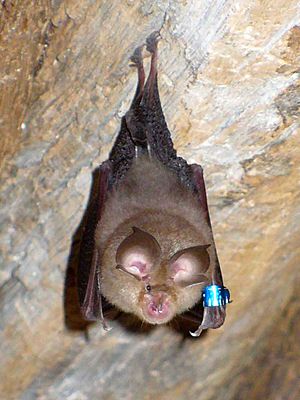Horseshoe bat facts for kids
Quick facts for kids Horseshoe bats |
|
|---|---|
 |
|
| Lesser horseshoe bat (Rhinolophus hipposideros) with blue metallic identification band on left wing | |
| Scientific classification |
|
| Kingdom: | Animalia |
| Phylum: | Chordata |
| Class: | Mammalia |
| Order: | Chiroptera |
| Family: | Rhinolophidae Gray, 1825 |
| Subfamily: | Rhinolophinae Gray, 1825 |
| Genus: | Rhinolophus Lacépède, 1799 |
| Type species | |
| Vespertilio ferrum-equinum Schreber, 1774
|
|
| Species | |
|
|
Rhinolophidae is a family of bats that are often called horseshoe bats. They get this name because of their special nose shape. These bats are found mostly in warm, tropical, or subtropical places. You can find them in Africa, Asia, Europe, and Oceania.
Horseshoe bats are related to another bat family called Hipposideridae. Scientists believe that all horseshoe bats came from a common ancestor that lived a very long time ago, about 34 to 40 million years ago! There was even an extinct type of horseshoe bat called Palaeonycteris.
Like many wild animals, bats can sometimes carry germs. Scientists study this to understand how to keep everyone healthy. In some parts of the world, like Sub-Saharan Africa and Southeast Asia, people hunt these bats for food. Also, some species or their droppings (called guano) are used in traditional medicine in places like Nepal, India, Vietnam, and Senegal.
Contents
About Horseshoe Bats
Horseshoe bats are generally small to medium-sized bats. They usually weigh between 4 and 28 grams, which is about as much as a few paperclips! Their forearms can be from 30 to 75 millimeters long, and their head and body together measure about 35 to 110 millimeters.
Their fur can be different colors, like reddish-brown, blackish, or even bright orange-red. Most species have long, smooth fur.
Wings and Flight
These bats have large wings compared to their body size. The shape of their wings helps them fly in a special way. They can make quick, sharp turns even when flying slowly. This makes them very agile in the air.
Nose-Leaf and Echolocation
The most unique thing about horseshoe bats is their large noses, which are called "nose-leafs." These nose-leafs are shaped like a horseshoe, which is how they got their common name!
The nose-leafs are super important for how these bats find their way around and hunt. They use a special skill called echolocation. This means they make high-pitched sounds with their nose. These sounds bounce off objects around them and come back as echoes. The bats listen to these echoes to create a mental map of their surroundings. This helps them find their prey, which are usually insects and spiders.
Life and Reproduction
Scientists are still learning a lot about how horseshoe bats mate and raise their young. We know that at least one species mates with only one partner (this is called monogamous). However, another species might mate with multiple partners (this is called polygynous).
After mating, the mother bat is pregnant for about seven weeks. She usually gives birth to just one baby bat at a time. Most horseshoe bats live for about six or seven years. But one amazing greater horseshoe bat lived for more than 30 years!
Where They Live
Some types of horseshoe bats prefer to live alone and roost by themselves. Other species are much more social and live in large groups. These groups can have thousands of bats living together in one place!
Images for kids
-
Skull of the greater horseshoe bat, showing the prominent rostral inflation on the snout
-
The nose-leaf helps focus echolocation; pictured is Rüppell's horseshoe bat (R. fumigatus)
-
Outline of Pearson's horseshoe bat (R. pearsonii) (top) compared to the European free-tailed bat (Tadarida teniotis), which is a molossid. Horseshoe bats have lower aspect ratios, lower wing loading, larger wing areas, and rounder wing tips. Molossids are adapted for fast, less maneuverable flight.
See also
 In Spanish: Rinolófidos para niños
In Spanish: Rinolófidos para niños






